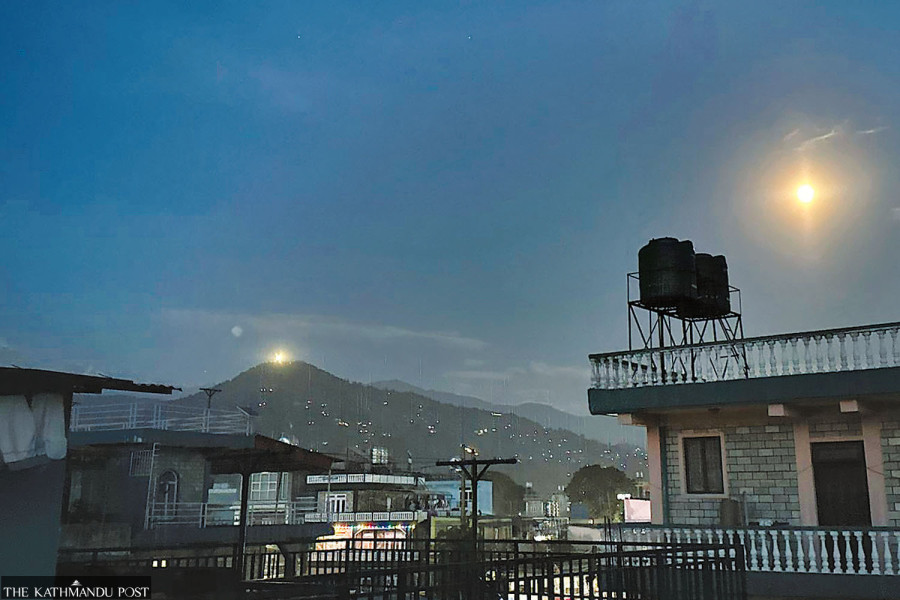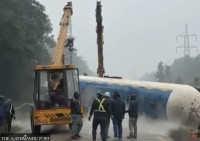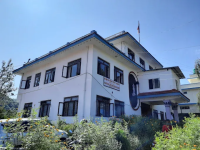National
Fireflies battle artificial light for survival in Pokhara
Male fireflies depend on bioluminescent cues to find mates. The males fly and flash, while the usually stationary females respond with their own flashes.
Deepak Pariyar
In late November, conservationist Hum Bahadur Gurung posted a photo on Facebook of “two moons”, one at a distance atop a hill and the other one in the north-east sky. The photo eerily jumps out as if from a sub-genre of apocalyptic fiction.
He has aptly captioned the photo—Two moons in Pokhara—piquing curiosity among those who saw his post. Further down the caption, he explains that the source of light on the hill is a high-mast light and shares his concerns for the nocturnal life that inhabit forest areas.
Gurung’s post has sparked conversation among conservationists and the general public alike about how the presence of anthropogenic artificial light in otherwise dark conditions stands to harm the biodiversity of affected areas.
A 16-metre tall high-mast light with eight 200-watt bulbs has been installed on the Arba hill in ward 13 of the Pokhara metropolis. The bright light is visible from the valley below.
The Nepal Electricity Authority (NEA) and Pokhara Metropolis have installed a total of 23 high-mast lights and 2,007 smart lights along 60 km of roads in Pokhara under the Bright City Campaign. Although the authorities planned to illuminate the thoroughfares of the city with these high-powered lights, one of them has been installed atop the hill.
Gurung, who is the Asia Partnership Manager of BirdLife International (Asia), says the light pollution in city areas has already started showing its adverse impact on the population of fireflies.
An estimated 2,200 species of fireflies are found worldwide.
However, very few studies have been conducted on fireflies in Nepal. At Gurung’s initiation, some 70 researchers have been studying fireflies in 40 districts of the country since 2021.
The population of fireflies is in sharp global decline, says Gurung. One of the major contributing factors is light pollution while the use of pesticides and insecticides in farmlands and habitat destruction have also affected their life cycle. Fireflies are active in the rainy season, while they live in bushes and wetlands at other times.
Male fireflies depend on bioluminescent cues to find mates. The males fly and flash, while the usually stationary females respond with their own flashes. In the presence of anthropogenic light, the males of the species fail to attract their mates leading to a decrease in their population, says Gurung.
“Development is good. But one should consider its negative consequences, especially on the environment while carrying out development activities,” said Gurung. “It is good to see people’s representatives focus on developing their constituencies, but they must also look at sustainable ways of doing so. I don’t see the need for a high-mast light in a heavily wooded area. The forests are the life source of so many species of insects, birds and animals. Installing artificial light in those areas interferes with their very nature, their growth and their life cycle.”
According to him, fireflies thrive in peaceful environments with fresh air, pure water and darkness. The unabated light pollution is making the environment unfavourable for fireflies, he says.
Sky glow, or the brightening of the night sky, by artificial lights affects the physiological processes in all living organisms. According to National Geography, World Atlas of Night Sky Brightness, a computer-generated map based on thousands of satellite photos, was published in 2016.
As seen on the map, more than 80 percent of the world’s population lives under sky glow caused by anthropogenic activities. Studies show that light pollution is also impacting insect behaviour, resulting in increased exhaustion, predation and disrupted ability to navigate.
According to environmentalists, fireflies are highly beneficial in gardens and agricultural lands. They feed on various species of soft-bodied invertebrates such as earthworms, snails and slugs.
Karan Bahadur Shah, another conservationist and Zoology professor, says fireflies go through four developmental stages—egg, larva, pupa and adulthood. Shah stresses the importance of protecting the habitat of the fireflies. “They are nocturnal, like the majority of insect species on earth,” he said. “Artificial light can have a big impact on their life cycles. It is important to protect them from exposure to artificial light.” A firefly lives for about a year.
“Before undertaking development activities, especially those that stand to affect other living organisms, the authorities concerned must consider the impact of such activities,” said Shah. “Environmental Impact Assessment must be carried out before installing high-power lights in forest areas.”
In partnership with the municipalities, the NEA has installed a total of 11,500 decorative smart lights and high-mast lights in various cities and towns over the past few months. Such lights are installed along major roads, historical places, cultural heritages and tourist destinations.
Pramod Rijal, chief of the national street light promotion project, said that the lights were installed according to the demands of local units. “Pokhara Metropolis decided the locations for the high-mast lights. We went and installed the lights where they asked us to,” said Rijal.
According to Dhruba Bhattarai, an engineer at Pokhara Metropolis, around Rs1.2 to Rs1.3 million was spent on the installation of the high-mast lights. The metropolis incurs an estimated electricity bill of Rs100,000 to Rs150,000 per high-mast light per year.
Mayor of Pokhara Metropolitan City Dhanaraj Acharya defended the metropolis’ decision to install the high-mast light at Arba hill. “Mahaprabhudham, a religious tourist destination, is in Arba. The high-mast light has been installed there as per the ward’s demand,” he said. “We only met the demand by the ward that wants to promote the religious destination to boost tourism.”




 11.12°C Kathmandu
11.12°C Kathmandu.jpg)













%20(1).jpg&w=300&height=200)

